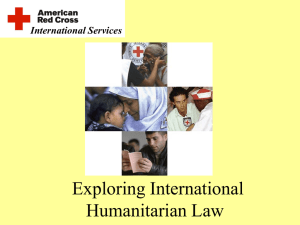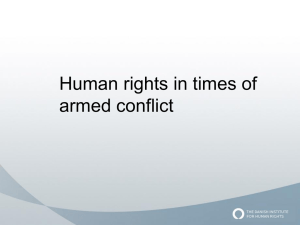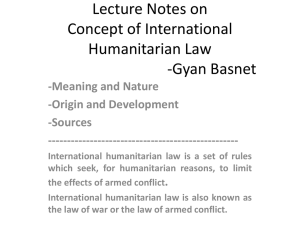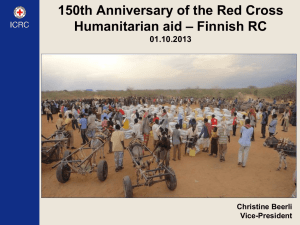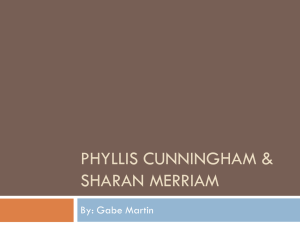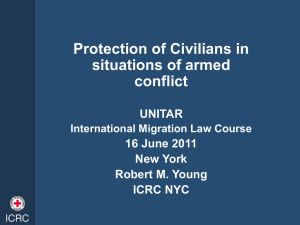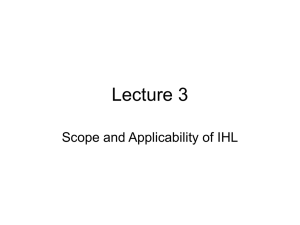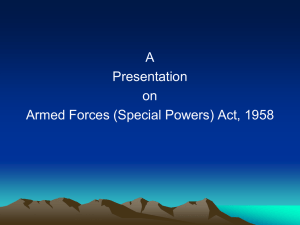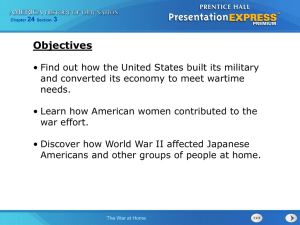Microsoft PowerPoint 2007
advertisement
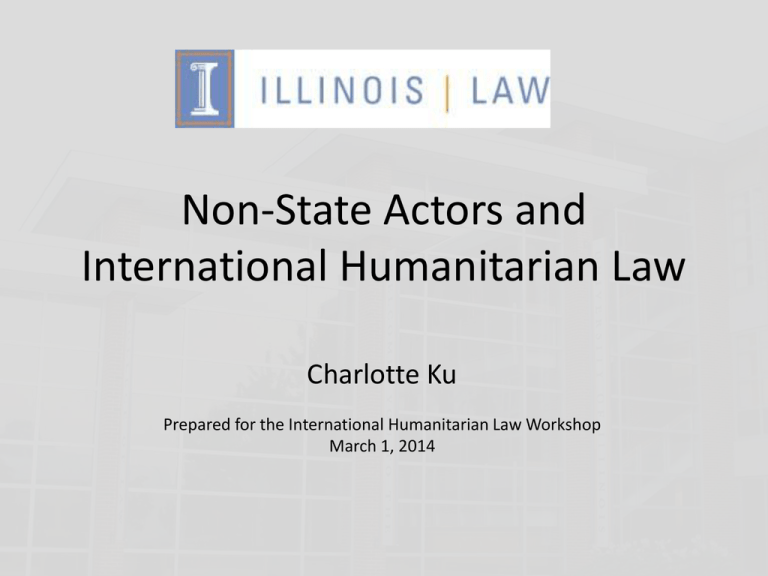
Non-State Actors and International Humanitarian Law Charlotte Ku Prepared for the International Humanitarian Law Workshop March 1, 2014 1949 Geneva Conventions Common Article 2: “…the present Convention shall apply to all cases of declared war or of any other armed conflict which may arise between two or more of the High Contracting Parties…” Common Article 3: “armed conflict not of an international character occurring in the territory of one of the High Contracting Parties…” law.illinois.edu 1977 Protocols to the 1949 Conventions Protocol I (173 parties) included a provision to extend coverage of common Article 2 to “armed conflicts in which peoples are fighting against colonial domination and alien occupation and against racist regimes in the exercise of their right of self-determination…” Protocol II (167 parties) sought to extend coverage of common Article 3 to “armed forces and dissident armed forces or other organized armed groups which, under responsible command, exercise such control over a part of its territory as to enable them to carry out sustained and concerted military operations…” law.illinois.edu Graduated List of IHL Regimes • Disturbances and tensions such as riots • Armed conflicts “not of an international character” within the territory of a state • Armed conflict against colonial domination, occupation, and racist regimes • Full international armed conflict and declared war law.illinois.edu Prosecutor v. Tadić (ICTY 1995) …an armed conflict exists whenever there is a resort to armed force between States or protracted armed violence between governmental authorities and organized armed groups or between such groups within a State. IHL applies from the initiation of such armed conflicts and extends beyond the cessation of hostilities until a general conclusion of peace is reached; or, in the case of internal conflicts; a peaceful settlement is achieved. IHL….applies in the whole of the territory under the control of a party whether or not actual combat takes place there. law.illinois.edu law.illinois.edu Terrorists as Non-State Actors 1963 Offences and Certain Other Acts Committed on Board Aircraft 1970 Convention for the Suppression of Unlawful Seizure of Aircraft 1999 International Convention for the Suppression of the Financing of Terrorism law.illinois.edu Military Order, 13 November 2001 International terrorists, including members of al Qaida, have carried out attacks on United States diplomatic and military personnel and facilities abroad and on citizens and property within the United States on a scale that has created a state of armed conflict that requires the use of the United States Armed Forces. law.illinois.edu Presidential Memorandum 7 February 2007 …the war against terrorism ushers in a new paradigm, one in which groups with broad, international reach commit horrific acts against innocent civilians, sometimes with the direct support of states. Our nation recognizes that this new paradigm – ushered in not by us, but by terrorists – requires new thinking in the law of war, but thinking that should nevertheless be consistent with the principles of Geneva. law.illinois.edu ICRC View The 1949 Geneva Conventions and the rules of customary international law were fully applicable to that international armed conflict, which involved the U.S. led coalition, on the one side, and Afghanistan, on the other side. [As to terrorists]: [o]n the basis of currently available factual evidence it is doubtful whether these groups and networks can be characterized as a ‘party’ to a conflict within the meaning of IHL. law.illinois.edu Options for Applying IHL to Terrorism Equate terrorism to armed conflict Treat terrorism as domestic or even international crime Ad hoc determinations based on scale and location law.illinois.edu 2008 ICRC Interpretive Guidance civilians whose “continuous function is to take part in hostilities” could be considered combatants -- not the same as the traditional uniformed combatant -- but also not treated as a protected civilian However, the level of force could be used against such individuals should not exceed what is needed in order to meet a military objective. law.illinois.edu IHL and other Non-State Actors: The United Nations 1999 United Nations Secretary-General’s Bulletin, “Observance by United Nations forces of international humanitarian law”: the fundamental principles and rules of international humanitarian law …. are applicable to United Nations forces in situations of armed conflict they are actively engaged therein as combatants… They are accordingly applicable in enforcement actions, or in peacekeeping operations when the use of force is permitted in self-defence. law.illinois.edu IHL and other Non-State Actors: The United Nations Peacekeeping Fact Sheet (as of 31 December 2013) Peacekeeping operations since 1948: 68 Current peacekeeping operations: 15 Uniformed personnel: 97,904 Troops: 83,008 Police: 13,053 Military observers: 1,843 Civilian personnel: 16,822 (as of 31 August 2013) International: 5,128 Local: 11,694 UN Volunteers: 2,029 Total number of personnel serving in 15 peacekeeping operations: 116,755 Countries contributing uniformed personnel: 122 Total fatalities: 3,186 law.illinois.edu IHL and other Non-State Actors: The United Nations We will comply with the Guidelines on International Humanitarian Law for Forces Undertaking United Nations Peacekeeping Operations and the applicable portions of the Universal Declaration of Human Rights as the fundamental basis of our standards. We will never: Commit any act that could result in physical, sexual or psychological harm or suffering to members of the local population, especially women and children law.illinois.edu IHL and other Non-State Actors • Contractors • Humanitarian Aid Organizations law.illinois.edu The United Nations law.illinois.edu The United Nations law.illinois.edu

